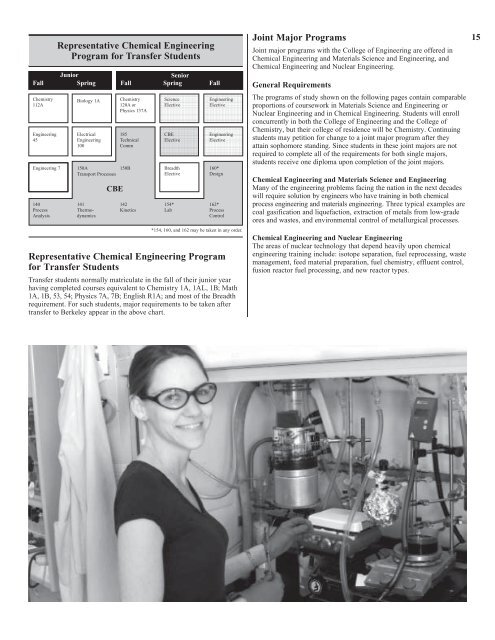12-13 Coc Guide v7 - College of Chemistry - University of ...
12-13 Coc Guide v7 - College of Chemistry - University of ...
12-13 Coc Guide v7 - College of Chemistry - University of ...
You also want an ePaper? Increase the reach of your titles
YUMPU automatically turns print PDFs into web optimized ePapers that Google loves.
Junior Senior<br />
Fall Spring Fall Spring Fall<br />
<strong>Chemistry</strong><br />
1<strong>12</strong>A<br />
Engineering<br />
45<br />
Engineering 7<br />
140<br />
Process<br />
Analysis<br />
Representative Chemical Engineering<br />
Program for Transfer Students<br />
Biology 1A<br />
Electrical<br />
Engineering<br />
100<br />
CBE<br />
<strong>Chemistry</strong><br />
<strong>12</strong>0A or<br />
Physics <strong>13</strong>7A<br />
185<br />
Technical<br />
Comm<br />
150A 150B<br />
Transport Processes<br />
141<br />
Thermodynamics<br />
142<br />
Kinetics<br />
Science<br />
Elective<br />
CBE<br />
Elective<br />
Breadth<br />
Elective<br />
154*<br />
Lab<br />
Engineering<br />
Elective<br />
Engineering<br />
Elective<br />
160*<br />
Design<br />
162*<br />
Process<br />
Control<br />
*154, 160, and 162 may be taken in any order.<br />
Representative Chemical Engineering Program<br />
for Transfer Students<br />
Transfer students normally matriculate in the fall <strong>of</strong> their junior year<br />
having completed courses equivalent to <strong>Chemistry</strong> 1A, 1AL, 1B; Math<br />
1A, 1B, 53, 54; Physics 7A, 7B; English R1A; and most <strong>of</strong> the Breadth<br />
requirement. For such students, major requirements to be taken after<br />
transfer to Berkeley appear in the above chart.<br />
Joint Major Programs<br />
Joint major programs with the <strong>College</strong> <strong>of</strong> Engineering are <strong>of</strong>fered in<br />
Chemical Engineering and Materials Science and Engineering, and<br />
Chemical Engineering and Nuclear Engineering.<br />
General Requirements<br />
The programs <strong>of</strong> study shown on the following pages contain comparable<br />
proportions <strong>of</strong> coursework in Materials Science and Engineering or<br />
Nuclear Engineering and in Chemical Engineering. Students will enroll<br />
concurrently in both the <strong>College</strong> <strong>of</strong> Engineering and the <strong>College</strong> <strong>of</strong><br />
<strong>Chemistry</strong>, but their college <strong>of</strong> residence will be <strong>Chemistry</strong>. Continuing<br />
students may petition for change to a joint major program after they<br />
attain sophomore standing. Since students in these joint majors are not<br />
required to complete all <strong>of</strong> the requirements for both single majors,<br />
students receive one diploma upon completion <strong>of</strong> the joint majors.<br />
Chemical Engineering and Materials Science and Engineering<br />
Many <strong>of</strong> the engineering problems facing the nation in the next decades<br />
will require solution by engineers who have training in both chemical<br />
process engineering and materials engineering. Three typical examples are<br />
coal gasification and liquefaction, extraction <strong>of</strong> metals from low-grade<br />
ores and wastes, and environmental control <strong>of</strong> metallurgical processes.<br />
Chemical Engineering and Nuclear Engineering<br />
The areas <strong>of</strong> nuclear technology that depend heavily upon chemical<br />
engineering training include: isotope separation, fuel reprocessing, waste<br />
management, feed material preparation, fuel chemistry, effluent control,<br />
fusion reactor fuel processing, and new reactor types.<br />
15




